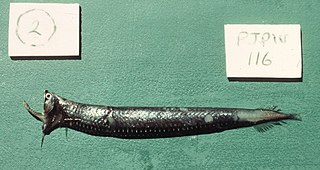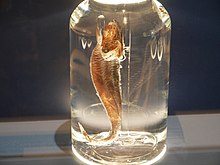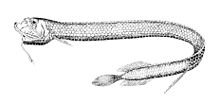
A viperfish is any species of marine fish in the genus Chauliodus. Viperfishes are mostly found in the mesopelagic zone and are characterized by long, needle-like teeth and hinged lower jaws. A typical viperfish grows to lengths of 30 cm (12 in). Viperfishes undergo diel vertical migration and are found all around the world in tropical and temperate oceans. Viperfishes are capable of bioluminescence and possess photophores along the ventral side of their body, likely used to camouflage them by blending in with the less than 1% of light that reaches to below 200 meters depth.

Stomiidae is a family of deep-sea ray-finned fish, including the barbeled dragonfishes. They are quite small, usually around 15 cm, up to 26 cm. These fish are apex predators and have enormous jaws filled with fang-like teeth. They are also able to hinge the neurocranium and upper-jaw system, which leads to the opening of the jaw to more than 100 degrees. This ability allows them to consume extremely large prey, often 50% greater than their standard length.

Sloane's viperfish, Chauliodus sloani, is a predatory mesopelagic dragonfish found in waters across the world. The species was first described by German scientists Marcus Elieser Bloch and Johann Gottlob Schneider in their 1801 book Systema ichthyologiae: iconibus CX illustratum, volume 1. Female C. sloani reach maturity between 133 and 191 mm, while males likely reach maturity at slightly smaller body lengths. It has two rows of photophores along its ventral side. It is believed that C. sloani can adjust the intensity of bioluminescence of the ventral photophores to camouflage itself from predators that might see its shadow from below.
Stomias boa boa, also called the scaly dragonfish or boa dragonfish, is a subspecies of abyssal barbeled dragonfish of the family Stomiidae. It is found at great depths worldwide in tropical to temperate oceans but is absent from the northern Pacific and northwest Atlantic Oceans.

Stomias is a genus of barbeled dragonfishes. They live in the mesopelagic zone of all oceans and show diel vertical migration and sexual dimorphism (males are smaller, have larger eyes and larger postorbital photophores than females.
Stomias affinis, also known as Gunther's boafish, is a deep-sea mesopelagic fish species in the family Stomiidae. They inhabit the open seas in the equatorial zones of the Atlantic, Indian and Pacific Oceans.
The smooth sandeel is a species of sand eel in the family Ammodytidae.

Scopelogadus beanii, or Bean's bigscale, is a species of ridgehead fish. It is named for Tarleton Hoffman Bean.
The sharpchin barracudina is a species of fish in the family Paralepididae (barracudinas).
The large-eye snaggletooth, also called the straightline dragonfish or Antarctic snaggletooth, is a species of fish in the family Stomiidae.
Schnakenbeck's searsid is a species of fish in the family Platytroctidae (tubeshoulders).
The Arctic rockling, also called the silver rockling or Arctic threebeard, is a species of fish in the family Lotidae.
Leptostomias gladiator is a species of fish in the family Stomiidae. It is sometimes called the scaleless dragonfish, but that name is shared with many other species.
Sudis hyalina is a species of fish in the family Paralepididae (barracudinas).
Agassiz' smooth-head is a species of fish in the family Alepocephalidae. It is named for the scientist and engineer Alexander Agassiz (1835–1910), who commanded the 1899 survey aboard the USS Albatross on which the fish was discovered.
The blackhead salmon is a species of fish in the family Alepocephalidae (slickheads).
Maul's searsid, also called Maul's tubeshoulder, is a species of fish in the family Platytroctidae (tubeshoulders), named for Günther Maul.
Stomias boa ferox is a subspecies of deep-sea fish in the family Stomiidae.

The white-spotted lantern fish, also called Rafinesque's lanternfish, is a species of fish in the family Myctophidae.










